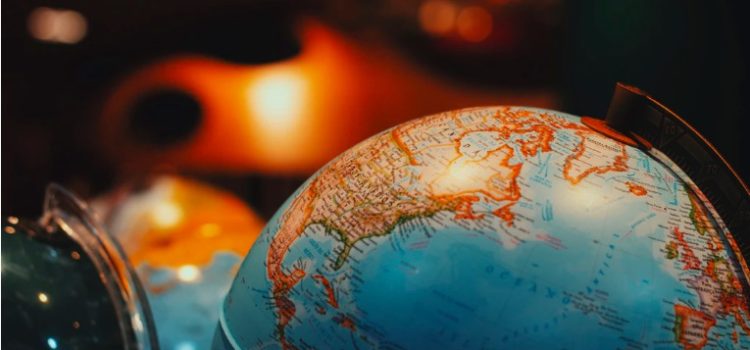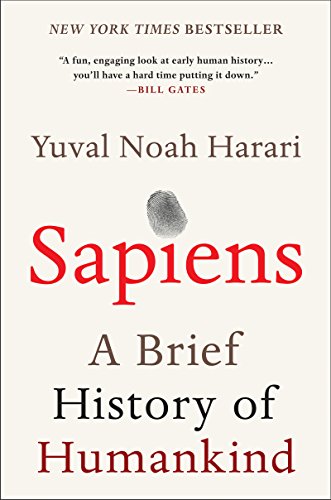

This article is an excerpt from the Shortform summary of "Sapiens: A Brief History of Humankind" by Yuval Noah Harari. Shortform has the world's best summaries of books you should be reading.
Like this article? Sign up for a free trial here .
What are the major events in the cultural evolution of man? How did these events shape our cultures today?
The cultural evolution of man has been shaped by changes in the ways we think, our language, and the ways by which we relate to each other. Language, especially, has had a powerful role in creating the global culture we recognize today.
We’ll cover the events of man’s cultural evolution and how language brought people together to create a global society.
The Cultural Evolution of Man
The Cognitive Revolution
The first major event in the cultural evolution of man was the Cognitive Revolution. 2.5 million years ago, Homo sapiens was just one of eight human species. The first major revolution for Sapiens was the Cognitive Revolution 70,000 years ago. Before that point, Sapiens weren’t particularly special and weren’t superior to the other seven human species. The Cognitive Revolution involved the development of three new abilities, all related to language, that helped Homo sapiens outpace their fellow humans.
Ability #1: Flexible Language
One reason the language of Sapiens was different was that it was more complex. Rather than communicating simple ideas the way green monkeys do (“Careful! A lion!” or “Careful! An eagle!”), the language of Sapiens could warn someone about a lion, describe its location, and plan how to deal with it. This allowed them to plan and follow through on complex actions like avoiding predators and working together to trap prey.
Ability #2: Gossip
A second distinction of the Sapiens language was its ability to convey gossip. We think of gossip as a bad thing, but using language to convey information about other people is a way to build trust. Trust is critical for social cooperation, and cooperation gives you an advantage in the struggle to survive and pass on your genes. Sapiens could form groups of up to 150 people. They didn’t need to know every group member personally to trust them. In a battle, a small group of Neanderthals was no match for a group of 150 Sapiens.
Ability #3: Fictions
A third benefit of the Sapiens’ language was how it was used to create fictions, also known as “social constructs” or “imagined realities.”
Being able to communicate information about things that don’t exist doesn’t seem like an advantage. But Sapiens seem to be the only animals who have this ability to discuss things that don’t have a physical presence in the world, like money, human rights, corporations, and God.
In and of itself, imagining things that don’t exist isn’t an asset—you won’t aid your chances of survival if you go into the forest looking for ghosts rather than berries and deer.
What’s important about the ability to create fictions is the ability to create collective fictions, fictions everyone believes.
Although imagined, these myths are crucial. Without collective fictions, the systems built on them collapse. Most of our modern systems are built on these imagined realities. These myths are powerful, and the fact that they’re not rooted in objective reality doesn’t undermine them. This was a major turning point in the cultural evolution of man.
Collective fictions allowed early Sapiens to cooperate within extremely large groups of people, most of whom they’d never met, and it rapidly changed their social behavior.
The Fiction of the Political Order
The next major stage in man’s cultural evolution came with the invention of the political order.
People evolved to cooperate in small groups. As their way of life changed rapidly, there was no time for Sapiens to evolve the skills of mass cooperation. As groups of people got bigger, they needed some kind of organizing structure, a way to help people work together to divide land, settle disputes, and keep the peace. Organizing so many people involved creating myths that served as the links between previously distinct bands of people. This was the foundation of cooperation.
Cooperation didn’t necessarily mean egalitarian collaboration. Cooperation was often built on oppression. Those in power exploited the farmers to maintain the system.
Fictions can foster cooperation among nations and empires. We’ll look at the Code of Hammurabi and the Declaration of Independence together to demonstrate how these seemingly dissimilar documents actually function very similarly.
Two Examples of How Myths Can Sustain Empires
Fictions can be useful. We like to think that political orders are founded on truths, but in reality, political orders are unable to function without relying on fictions. We’ll see over and over how important fictions were (and are) to the cultural evolution of man.
The Code of Hammurabi
In 1776 BC, the Babylonian Empire was the biggest in the world, with over a million subjects. King Hammurabi established a code that presented his power and legal system as mandated by the gods. The code emphasized hierarchy, breaking the population into “superior people,” commoners, and slaves. Your worth was established based on your class and gender.
The idea was that if everyone accepted this code, the empire’s million subjects could cooperate with each other. And it worked. People believed the myth that the gods dictated these laws, rights, and differing human worths, and the Code of Hammurabi is still known today.
The American Declaration of Independence
It’s easy to think of the Code of Hammurabi as a myth. It may not be as easy to think of our own country’s foundational document as a myth. But seeing it for the fiction it is can help us better understand man’s cultural evolution.
Similar to Hammurabi’s assertion that his code came from the gods, Thomas Jefferson justifies the rights proclaimed in the Declaration of Independence by writing that they are “endowed by [men’s] Creator.” Both have a divine source. Also like the Code of Hammurabi, the Declaration of Independence was written as a way to unify disparate groups of people.
Unlike the Code, the Declaration is based not on hierarchy but on equality. Who’s right? Neither. The concepts of rights and equality are just as much myths as the concepts of hierarchy and of value based on class and gender. They exist only in the mind.
In order for the phrase “all Men are created equal” to be true, we’d have to find that sentiment in the physical world. But there’s no sense in which we are equal in objective reality. People have different genes, are influenced by different environments, develop different personalities, and have different chances of success and survival. The evolution of our species depends on our differences, our genetic mutations.
There’s also no objective existence of “rights.” For example, birds don’t fly because they have the right to fly. They fly because they have wings. Likewise, “liberty” is a concept humans invented. You can’t measure it and it doesn’t exist outside our minds.
None of this means that the Declaration of Independence is a lie or worthless. It has helped create a stable, cooperative society. In fact, collective myths are the only way to organize large groups effectively.
The Invention of Writing
The next major turning point in the cultural evolution of man was the invention of writing. Although today we connect the word “writing” with “literature,” early writing was used to record tax payments, debts, and property ownership, not to write poems and stories. Writing also wasn’t invented to record spoken language. It was invented to fill a gap, to succeed where spoken language failed. It was needed to record data.
The Sumerians invented writing in southern Mesopotamia between 3500 BC and 3000 BC. Eventually, the Sumerians wanted to record more than just mathematical data, so they gradually added signs to their script, which developed into a script capable of representing spoken language. We call it cuneiform.
People who weren’t accountants started writing. Kings used cuneiform to give orders, priests used it to write down oracles, and citizens wrote letters. Also around 2500 BC, the Egyptians developed hieroglyphics. Soon after, societies in China and Central America developed full scripts.
It was only after the spread of full scripts that people started writing histories, dramas, prophecies, and poetry. Works that existed only through the passing down of oral tradition, such as the Hebrew Bible, the Iliad, and the Buddhist Tripitaka, began to be written down.
As we’ve seen, Sapiens evolve genetically to organize themselves into large groups, so they formed societies through the use of imagined orders and writing.
The Cultural Evolution of Man: Imagined Hierarchies
We require these imagined orders to function, but they’re not equitable or impartial. They result in systems that discriminate some and privilege others. In fact, there’s no known society that doesn’t discriminate. Unfortunately, discrimination seems to be an intrinsic part of the cultural evolution of man.
Hierarchies have a purpose: they let us know how to interact with others without actually knowing them, which in theory is more efficient and lets us function in large societies. For instance, a woman selling flowers doesn’t know all her customers personally. To figure out how to divvy up her energy and time, she uses the social cues dictated by each person’s place in the hierarchy—such as the way he’s dressed, his age, and, often, his skin color—to determine who is the executive, likely to buy a lot of expensive roses, and who is the messenger boy, only able to afford daisies.
Almost all hierarchies are imagined (we’ll look at a possible exception, the hierarchy of males and females, at the end of this chapter). But we usually claim that they’re natural. For example, capitalists believe that the rich are wealthy because they have better business sense, make better choices, and are smarter and harder working. They earn their wealth and the high-quality health care, education, and nutrition that come with it. But (according to Harari) it’s proven that most rich people are wealthy because their parents were wealthy, and that most poor people are poor because their parents were poor. Wealth is rarely purely “earned.”
Just because our hierarchies are imagined doesn’t mean there isn’t diversity in our biological aptitudes and abilities. Some people are smarter or more skilled than others. But we don’t succeed or fail based on these aptitudes alone. Society still largely determines who wins and who loses by dictating whose abilities are nurtured and who get what opportunities.
How Hierarchies Are Formed
Imagined societies are generally propped up by three elements: a historical accident, the fear of pollution, and the vicious cycle of discrimination.
Historical Accident: The roots of prejudicial hierarchies often lie in a random occurrence in history rather than biological differences.
Fear of Pollution: Humans are biologically programmed to feel repulsed by people and animals that might carry disease. This is a survival instinct. But although the fear is biologically-based, its historical manipulation and exploitation is based in fiction. If you want to ostracize a group (such as Jews, gays, blacks, or women), tell your society that they’re polluted and could contaminate you if you interact with them.
Vicious Cycle of Discrimination: Once a random historical event that benefits one group and discriminates against another occurs, that hierarchy is perpetuated by the people who benefit from it. This reinforces the prejudices used to justify the system. These prejudices, in turn, help maintain the system, and the cycle continues.
The Invention of Culture
Finally, the cultural evolution of man brings us to what we recognize today as “culture.” Culture is the “network of artificial instincts” that connect us, myths so ingrained that we take them for granted. As we’ve seen, these myths allow us to cooperate and thrive in large groups.
Cultures aren’t static. They may have values and norms based on tradition, but they’re still in constant flux. Chapter 9 looks at how cultures evolve, whether that evolution is linear, and where our cultures are headed.
The Value of Cognitive Dissonance in Man’s Cultural Evolution
Cultural changes may be a result of pressures from external factors like the environment or neighboring cultures. Or they may be the product of internal factors like the contradictions inherent in every culture. Psychologists call these contradictions cognitive dissonance. Cognitive dissonance occurs when we hold two or more thoughts or beliefs that are incompatible with one another.
Every single culture contains contradictions that lead to cognitive dissonance, and they’re actually beneficial. This is because cultures continually attempt to resolve and reconcile the contradictions in their myths. This leads to change, allowing for a more creative and dynamic species. Contradictions in our beliefs force us to examine them and reassess, and this moves culture forward.
For example, in the West, we prize both equality and individual freedom, but we can’t have them both.
- Equality: In order for everyone to have the same opportunities and freedoms, the opportunities and freedoms of some need to be limited and transferred to those who lack them.
- Individual freedom: If you prioritize everyone being free to do what they want, some people will lose their freedoms while others will gain a disproportionate amount of freedom. Equality disappears.
In America, Democrats favor equality. They’re willing to sacrifice the individual freedoms of a few (such as raising taxes for the rich) to make a more equitable society. Republicans, on the other hand, favor individual freedom. They don’t believe that others should be able to tell them how to spend their money, for instance, and they aim to increase individual freedom, even if it comes at the price of a widening income gap and poor Americans who can’t afford health care.
Because people resolve a culture’s contradictions in different ways, those contradictions lead to the multitude of varied opinions necessary for a creative, productive culture. A culture’s contradictions are its most telling features.
The Direction of Culture Toward Unity
Due to the attempt to resolve cognitive dissonances, cultures are continually evolving. Is this cultural evolution random?
The cultural evolution of man has a direction, and it’s toward unity. Speaking generally, over time, many small cultures tend to merge to form fewer, larger, more sophisticated cultures. Despite disintegration at the micro-level throughout history, such as the spread of Latin throughout the world dissolving into many regional and national languages, the overall trend is toward the consolidation of many distinct worlds.
The Merging of Worlds
Today, we have a global culture, but for most of history, the earth was a “galaxy of isolated human worlds.” In 10,000 BC, there were thousands of distinct cultures. But by AD 1450, 90% of the world’s population lived in the “mega-world” of Afro-Asia, in which Asia, Europe, and Africa were connected by culture, politics, and trade. By 1788, the world of Afro-Asia had absorbed all the rest, including Tasmania, the last autonomous world.
Consequently, today, all humans are tied by:
- A shared geopolitical system (for instance, states and nations are internationally recognized)
- A shared legal system (international law exists, although it’s more powerful in some areas than in others)
- A shared scientific system (scientific knowledge about, say, the structure of an atom is the same everywhere)
- And a shared economic system (capitalism and trade influence every area of the world)
This doesn’t mean that the global culture is homogeneous, but it does mean that we all “speak the same language,” metaphorically.
Us Against Them
Our survival instincts predispose us to divide the world into the people around us, “Us,” and everyone else, “them.” But just within the last few centuries, three “orders” have begun to dissolve this biological antagonism. These imagined orders are particularly remarkable because they run counter to our biological tendency to divide, instead being based on the potential of every human to be part of a single, united society. This may be the endpoint, in one sense, of the cultural evolution of man.
———End of Preview———

Like what you just read? Read the rest of the world's best summary of "Sapiens" at Shortform . Learn the book's critical concepts in 20 minutes or less .
Here's what you'll find in our full Sapiens summary :
- How Sapiens outlived and outlasted the 8+ other human-like species on Earth
- The 3 critical revolutions in human existence that led to our domination of the planet
- How much of what powers our world today is really just a shared mass delusion
- What the future of humanity might look like






